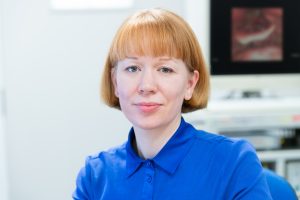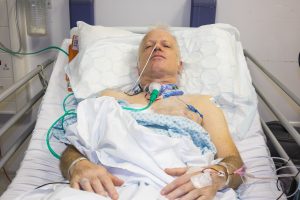In conversation with: Dr Gemma Clunie, Senior Clinical Academic Speech and Language Therapist working within: Sackler MSK Lab, Surgery & Cancer and PERC Fellow (2024)

What is your research project about and what stage are you at?
Airway stenosis (AS) is a narrowing of the windpipe between throat and lungs. People with AS experience a range of distressing symptoms such as shortness of breath, wheeziness, a hoarse voice and swallowing difficulties. Many patients have complicated surgery to widen their throat and improve their breathing. The picture included below shows one of my PhD research participants immediately after this surgery. He has his own blog and photo diary that can be found here. No one knows how this affects their voice and swallowing but patients told me they had problems. I investigated these voice and swallowing problems during my PhD. I am now evaluating the impact of my work and continuing to disseminate the results of my research.

What did you want patients/the public to help you with?
I wanted patients/the public to both help me to:
- design my research so that it was relevant to their lived experience and to a question they wanted to be answered in relation to living with AS; and
- continue to advise me as my research project continued.
It was important to me that the research project I carried out had real world relevance and was focused on a gap that patients themselves had identified.
Who did you involve and how did you find them?
I applied for funding from the “Enabling Involvement Fund” through the NIHR Research Design Service (now sadly defunct) and used the money to hold a focus group with patients and carers who had participated in some previous co-design work within our clinical service at the National Centre for Airway Reconstruction (NCAR) at Imperial College Healthcare NHS Trust. These patients had been treated for their AS at NCAR. This group became my patient advisory group, joined by another research-experienced patient advisor who runs an online support group for AS with over 7000 members.
What kind of activity did you undertake to gain insights about your research from public contributors?
I ran a focus group (in-person) to discuss my research ideas, and ask the patients/carers what was important to them in relation to AS, voice and swallowing. The “Enabling Involvement Fund” funding meant that I was able to pay for their time, travel and provide refreshments during the focus group.
Was any training/briefing provided to the people you involved?
The briefing involved sending information and explaining the project prior to the meeting and then using the initial meeting to ask for their opinions about research priorities relating to AS, voice and swallowing. I was fortunate that Catherine has significant research experience from her job role prior to living with AS.
How did your research change as result of the public involvement insights?
The key aspects that the patient advisory group helped me with were:
- Addition of a qualitative workstream and suggestions for how to collect information (given many participants have voice difficulties) – “The [focus groups] with patients are likely to be really informative. There are some interactive methods like drawing, writing, forming timelines that could be helpful for patients in telling their story if they are struggling with their voice as just talking for long periods of time could be challenging. This part will probably give a lot more information about what it’s really like for patients and how it affects them in their day-to-day lives. It also gives them a chance to say how they would like the service to be improved, which you don’t really get from the questionnaires.”
- Altered outcome – the patient reported outcome measure questionnaires I had planned to use were changed based on feedback from the group – they chose a questionnaire that asked more relevant questions based on their experiences.
- Altered timepoints for the outcome measures – I removed “day 1 post-surgery” from my timepoints for assessment as the group felt that this would be unfeasible due to: “The fear and shock after surgery (especially major surgery) can be a big issue”.
- Reviewed qualitative themes and analysis – this included sense-checking the overall labels given to the themes which related to a journey focusing on the emotional, physical, and medical aspects of care. The group were very keen that identity as a “person, not a patient” was reflected in the overall representation of experiences.
- Confirmation that expectations of patients participating in the study were acceptable and not too much of a burden.
- Development and piloting of a research survey focusing on mucus and cough.
- Dissemination to a much wider group than I would have expected – this particularly related to access to the online support group, and the wider email distribution list of both patients and clinicians held by Catherine and her support in disseminating the work.
- Development of my post-doctoral study (a Delphi Consensus project) – this has involved identifying a set of key outcomes from my PhD work and asking patients, clinicians, and researchers to vote on the importance of each outcome. The aim is to identify 6-8 outcomes (from an original list of 53) as a core outcome set for future research projects. The aim of a core outcome set is to make sure that researchers use consistent outcomes in their work which hopefully makes research more generalisable and clinically applicable.
The patient advisor who had research experience became co-author on one of my publications, and we presented together at two international conferences. She also helped me to develop a video animation of my PhD findings and supported a Twitter takeover via my professional body RCSLT to raise awareness of AS.
What impact did the Public Involvement have on the people involved?
This is one area of my public involvement work that I did not consider in enough depth. I have learnt a lot from being based at PERC over the last few months as a PERC Fellow about what I would need to do in future to make sure I captured the impact more successfully, including completing an impact log, and asking patients more specifically about their experiences of being involved in shaping and designing research.
However, the informal responses I had from my patient advisory group were always positive e.g.
“I think it’s great to be able to have input from us.”
“I found today’s session was useful – so glad to be able to assist in your next piece of research for AS. It was great to meet others face to face and share experiences together. Thank you for all you and Justin and team are doing to help us manage our lives with this condition.”
“Really interesting stuff, I’m happy to continue helping with your study.”
One final clinical impact is that the care pathway altered as a direct result of my PhD and hopefully is now providing patients with a better service. This involved:
- The introduction of a pre-treatment information session which is carried out with every patient listed for reconstructive surgery. This session is patient led, with a guidance document that allows them to identify the key subjects for discussion with the clinicians (usually at least a Speech and Language Therapist (SLT) and Clinical Nurse Specialist (CNS)). This was developed because of the need for individualised information provision.
- The formalisation of a multidisciplinary meeting where the surgeons, SLTs, CNS and other team members meet on a weekly basis to discuss each patient. The aim of this was to minimise the conflicting information provided to patients about their care and improve team communication.
What was the most challenging part of doing Public Involvement and how did you overcome it (or not)?
I think for me the most challenging part has been trying to identify a more diverse range of patient/public to provide feedback. The people I relied on most were overwhelmingly white, middle-aged women who represented a very specific subset of AS (described as idiopathic AS which means no-one knows why their AS has occurred, despite lots of investigations). To reach a broader demographic of patients was quite challenging, and I don’t think I did a very good job of widening the net. I did use email correspondence with some patients to ask their opinion of certain aspects of my research when they weren’t keen on attending groups and they were often from other demographic groups. In future I would look to extend the type of activities I used and the options for providing feedback to make it more inclusive.
What advice would you give other researchers interested in doing something like this?
Take the time to properly embed patients. The public should not be an optional extra, but should be key to any research that you do. It is time-consuming and hard work, but the benefits make it completely worthwhile.
So, what’s next?
When my PhD finished in 2022, I continued with my post-doctoral research, and have completed the Delphi Consensus study. Over 400 patients have participated in all 3 rounds of the voting. The consensus groups I held were with equal numbers of patients and clinicians/researchers which is very unusual for Delphi studies where the balance is often weighted towards professionals. I hope that my ongoing patient involvement work has been partly the reason for this.
Since January 2024, I have been one of the Imperial BRC PERC fellows. This has given me huge insight into the world of patient involvement and participatory research, and I hope to use this experience to guide my future research, as well as deliver training to the clinical teams at ICHT in good quality patient involvement.
